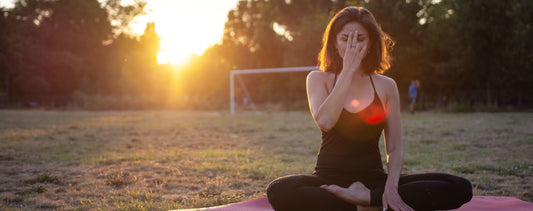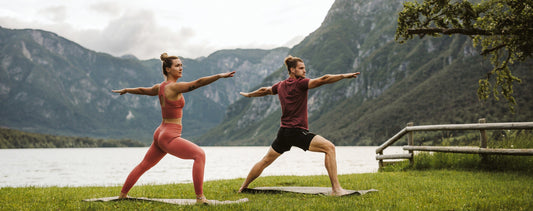If you have a dedicated asana practice, postures can tend to feel rote over the course of a lifetime. If you have a home practice, you may notice yourself doing the same poses in the same way, day after day. Yet like most things in life, whatever effort you put in to something, you get back tenfold. Infusing creativity into your yoga practice (whether you are a student or a teacher) can be the key to creating a lifelong practice that is sustainable, enlivening, and invigorating.
The poses hold within them many profound symbols and metaphors that can bring more magic and meaning to every moment spent in that pose. The next time you execute one of the following yoga postures, try going deeper by considering some of the symbolism inherent in their shape.
anjalimudra200x200.jpg Probably the most common and easily identifiable mudra, prayer position can happen in just about any pose. Most yogis are familiar with this mudra as an indicator of gratitude, respect, or prayer, but try this subtle shift to get more out of it: rather than pressing the palms flat against each other, cup your hands ever so slightly. This creates a small space between your palms, into which you mentally and energetically place the seed of your intention or prayer. Holding that small space consciously creates space for blessings to enter your heart and your life.
mountain200x200.jpg Tadasana is the foundation for all standing poses. It is solid, stable, and profound—as you yourself can be when you inhabit all the possibilities of this posture. When you want to feel grounded and balanced, you can envision yourself as the mountain—standing tall, steady, and expansive. When want to connect to your potential, and the vastness of the possibilities ahead (in your practice, day, or life), you can see yourself as standing on top of the mountain. With your third eye, envision the clouds, the birds, the treetops out beyond you and below you. Everything is possible in this pose, and if you’ve ever done Mountain pose ON a mountain, then you’ve tasted the majesty available to you.
tree.jpg Vrksasana gives you a chance to align with the beauty and wisdom of nature by encouraging you to extend your roots downward, while reaching your limbs and heart upward toward something higher. The shape of the pose calls for a strong standing leg (tree trunk), and the dispersion of energy asks you to be both steady and flexible. If a strong wind tries to blow you over in this pose, rigidity can cause a limb to break. Going with the wind, while staying rooted in your power, will help you to dance with grace no matter what comes your way.
eagle200x200.jpg The Eagle is a strong and regal bird, and is known in various myths as one of God’s messengers. As you sit deeply into the pose, you can imagine yourself flying between the earthly and spiritual planes, with an Eagle Eye that takes in the greater perspective of life. Garudasana (or Eagle pose) demands great focus and patience, as does living a life in accordance with Spirit. It can be easy to get bogged down with the challenges of life (or of this pose!), but a calm connection with the Divine can help you soar on your journey.
bakasana.jpg you to sharpen your vision while balancing atop life’s challenges. In order to successfully support yourself in this pose, you must keep your eyes fixed on a point out ahead of you or you may collapse. The crane must also focus its eyes into the murky and shallow waters before taking its next step; it must focus sharply on its prey, but do so with a quiet sense of poise. Bring more focus to your Drishti (focused gaze) the next time you do Bakasana, and feel yourself pierce through the murkiness ahead with your focused efforts and willingness.
bhujangasana.jpg And then there is the cobra, which sheds its skin and returns renewed and refreshed. The cobra has no arms so it uses its strong spine to lift its head. Engage your back to lift your heart when you’re in this pose, and consider it an opportunity to transform fear into love. Just as the cobra sheds its dead layers, you, too, can shed your limiting beliefs and thoughts that prevent you from living in a strong and heart-centered way.
anjaneyasana.jpg movement. Reaching your arms toward the Source that unites you with all of creation, you stretch your fingers to release any expectations, judgments, and unwillingness to accept whatever the experience may have to offer. By back bending over your back leg, you open your heart to the potential of divine connection. And with your strong legs supporting you, you drive your pelvis forward on the path ahead.
yoga.jpg Hanuman did in the Indian epic, the Ramayana. When leaping from one place to another, there is no turning back once you’ve launched off the edge. Courage, faith, and remembrance of your true Divine nature will get you there, if you position yourself in the direction you want to go. Your leap may be a movement away from something you wish to leave behind, but is always a gesture toward where you want to land. Get clear about your destination and point your heart toward it.
happy-baby.jpg simple things in life. In Ananda Balasana, or Happy Baby, you return to an innocent state of being, when you were delighted and entertained by holding your own feet! Find softness in your hips and back (babies are naturally so flexible), and hold space for appreciation in your heart as you gently rock from side to side.
savasana-2.jpg symbol for the circle of life, it is deeply healing and rejuvenating to your mind, body, and spirit. As you lay down on your back, imagine letting all the dead parts of yourself fall away. Bring the energy of an exhalation to your Savasana, and then reawaken with the energy of an inhalation. Sometimes the surrender required for a good Savasana is the hardest part of the practice, but you get better at it with practice. Each day, the sun sets, the flowers close their petals, and the birds quiet their song. Practice rest every day, and honor your natural rhythms.
The benefits of a yoga practice, executed with mindful awareness and a clear intention, can bring you many lifetimes of joy, health, and rewards. Do not feel limited by these suggestions, but rather let them inspire you to create your own symbolism for your postures. You’ll be more likely to sustain your lifelong love of yoga when you have a clear purpose every time you step onto your mat.
The poses hold within them many profound symbols and metaphors that can bring more magic and meaning to every moment spent in that pose. The next time you execute one of the following yoga postures, try going deeper by considering some of the symbolism inherent in their shape.
Anjali Mudra
Mountain Pose
Tree Pose
Eagle Pose
Crane
Another bird-inspired pose, Bakasana, or Crane pose, can helpCobra
Anjaneyasana
This beautiful and graceful lunge is a full body prayer all in oneHanumanasana
This pose gives you the chance to take a leap of faith, just likeHappy Baby
Here is a sweet reminder to cultivate joyful appreciation of theSavasana
Corpse pose can easily sound morbid, but when viewed as aThe benefits of a yoga practice, executed with mindful awareness and a clear intention, can bring you many lifetimes of joy, health, and rewards. Do not feel limited by these suggestions, but rather let them inspire you to create your own symbolism for your postures. You’ll be more likely to sustain your lifelong love of yoga when you have a clear purpose every time you step onto your mat.






















